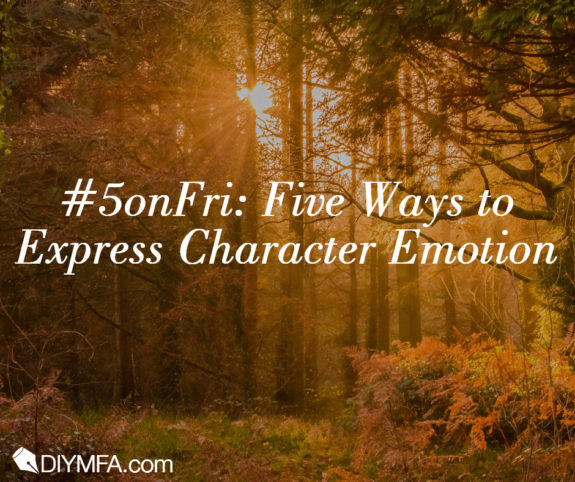Reading is an exercise in empathy. When we read an effective story, we identify with its main characters and mirror their emotions.
Indeed, the best stories get us to experience the events being portrayed. Studies have even shown that when readers encounter well-told stories, there’s cortex activity in their brains; that is, the areas of the brain that light up are literally the same areas that would light up were the readers experiencing first-hand the events they were reading about.
Not all stories do this, mind you. The best do; the well-told stories do.
And a big part of a story’s being well-told has to do with how the writer gets readers to identify with characters’ emotions. In fact, it’s stories that convince us of the authenticity and validity of character emotions that ring truest experientially.
In his book From Where You Dream, Robert Olen Butler claims that “emotions are . . . basically experienced, and therefore expressed in fiction, in five ways.” Let’s take a look at them.
1) Physical Responses Inside the Body
The first of Butler’s five expressions is “a sensual reaction inside our body—temperature, heartbeat, muscle reaction, neural change.” Rarely are such reactions perceivable to anyone but the person experiencing them, and even then, it takes a highly perceptive person to pay attention to sensual reactions inside their bodies during emotional encounters.
That may be appropriate during a particularly physical scene—a sex scene, or one involving other physical exertion, like rock climbing or boxing. But an over-reliance on these physical descriptions of emotional expression may come across as oddly clinical.
When people are engaged in emotional encounters, their attention tends not to be on their own bodies, and so if a POV character is nervous or excited, it may be awkward—not to mention cliché—to narrate their vitals. One can easily picture a physically-expressive scene descending quickly into a medical chart: I could feel my heart race as he pressed his lips to mine. As he ran his fingers down my back, my knees got weak. Elevated levels of oxytocin raced through my veins and my blood pressure, had I been able to take it at that moment, probably would have read 140/86.
2) Physical Responses Outside the Body
Second, “there is a sensual response that sends signals outside of our body—posture, gesture, facial expression, tone of voice, and so forth.”
These physical signals are what allow us to read emotions of other people. We can’t read their minds, but we can interpret the outward signs of what they’re feeling. We’re sometimes not even conscious of what it is we’re interpreting when we assess another’s emotional state—is it the minuscule relaxation of the facial muscles around the eyes? Is it the barely-detectable coloration of the skin that results from an elevated heart rate?—regardless, we do all our interpersonal interpreting through physically-expressed emotional signals.
What’s this mean for the writer? You’ll likely have a narrator who does not have access to every thought or feeling experienced by every character. Even omniscient narrators often remain on the outside of characters. In these cases, you have to rely on physical displays and whatever impression the POV characters have about the other characters in the story.
3) Flashes of the past
When you’re writing the experiences of your perspective characters, Butler’s other expressions of emotion tend to be richer soil. The third experience of emotion comes from flashes to the past. “Moments of reference in our past come back to us in our consciousness,” he states, “not as ideas or analyses about the past, but as little vivid bursts of waking dream; they come back as images, sense impressions.”
Flashbacks are certainly one iteration of this type of emotional expression, but writers can give us what James Scott Bell calls a “back flash,” a short evocation of the past, as in this excerpt from Fredrik Backman’s A Man Called Ove:
“He sits there for what must be an hour, just staring at that photo [of his wife]. Of all the imaginable things he most misses about her, the thing he really wishes he could do again is hold her hand in his. She had a way of folding her index finger into his palm, hiding it inside. And he always felt that nothing in the world was impossible when she did that.”
It’s that vivid image of the index finger folded into the palm that is the emotional heart of that flash to the past.
4) Flashes of the future
Butler’s fourth expression goes the other way in time: “Similar to flashes of the past, but of something that has not yet happened or that may happen, something we desire or fear or otherwise anticipate.” These flashes “also come to us as images, like bursts of waking dreams.”
Take this example from André Aciman’s Call Me by Your Name, in which Elio fantasizes about Oliver:
“About two weeks after his arrival, all I wanted every night was for him to leave his room, not via its front door, but through the French windows on our balcony. I wanted to hear his window open, hear his espadrilles on the balcony, and then the sound of my own window, which was never locked, being pushed open as he’d step into my room after everyone had gone to bed . . . .”
From there, it gets even steamier, but none of it is happening. It’s all imaginative longing for a future event, which reveals Elio’s longing.
5) Sensual Selectivity
And finally, there is what Butler calls “sensual selectivity.” It is often understood that the details being relayed by the narrator are the details the perspective character is paying attention to.
“At any given moment we, and therefore our characters, are surrounded by hundreds and hundreds of sensual cues. But in that moment only a very small number of those sensual cues will impinge on our consciousness. Now, what makes that selection for us? Well, our emotions do.”
Take, for example, this moment in Anthony Doerr’s short story “So Many Chances,” in which the protagonist, Dorotea has just moved with her family to Maine and is feeling a little isolated:
“Then she sees the fisherman. Just to her left. Wading. As if he came from nowhere. From nothing. From the sea itself.
She watches him. Feels lucky to watch. The world peeled back and left with only this vision. This silent flying wizardry. The rod seems an extension of his arm, an extra and perfect appendage, his shoulder pivoting, his bare brown chest, his legs tapering to calves buried in the sea. So this is Maine, this is how it can be, she thinks. This fisherman. This grace.”
Dorotea’s perception of the fisherman is colored by her fascination, hope, and attraction.
It’s tempting, and easiest, to just slap a label on a character’s emotion, as in “She was livid.” The typical “Show, Don’t Tell” advice would have you enact the emotion: She threw the book at him and screamed, “You never listen!” And enacting emotions is important and necessary and effective. But an angry person doesn’t always act out. And in those frequent cases when you want to show a character’s emotions before they act, Butler’s five expressions are very helpful.
So it’s worth experimenting with these expressions in order to create the most evocative scenes you can. Give your readers an experience.
 T.D. Storm is an award-winning writer and teacher whose work has appeared in a number of journals and anthologies, including Black Warrior Review, Copper Nickel, and Literary Hub. His passion for storytelling and its inner workings informs his teaching, editing, and mentoring. He runs an online writing school (stormwritingschool.com), which offers articles, worksheets, and courses geared toward helping writers hone their craft of engaging and moving stories. You can also connect with him on Facebook and Pinterest.
T.D. Storm is an award-winning writer and teacher whose work has appeared in a number of journals and anthologies, including Black Warrior Review, Copper Nickel, and Literary Hub. His passion for storytelling and its inner workings informs his teaching, editing, and mentoring. He runs an online writing school (stormwritingschool.com), which offers articles, worksheets, and courses geared toward helping writers hone their craft of engaging and moving stories. You can also connect with him on Facebook and Pinterest.







